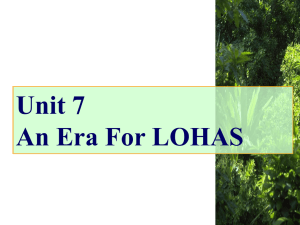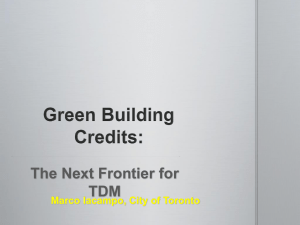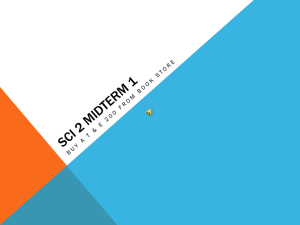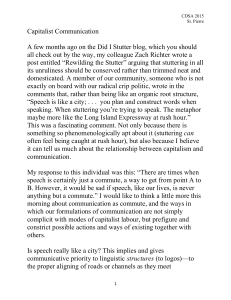case study - Bay Area Commuter Benefits Program
advertisement
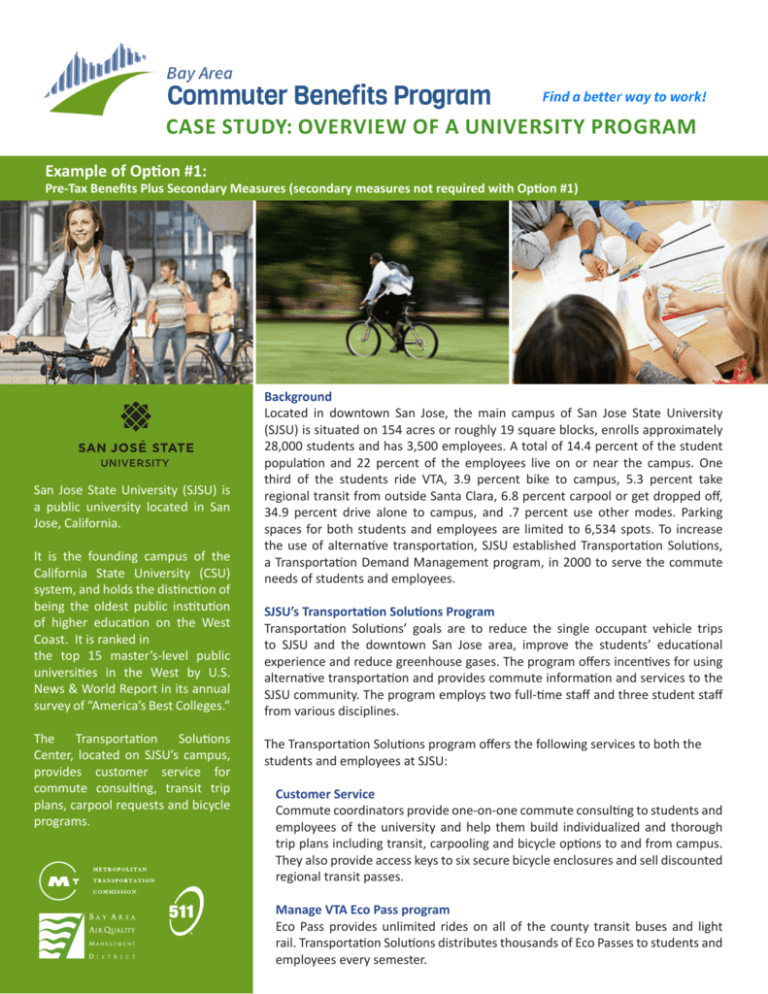
CASE STUDY: OVERVIEW OF A UNIVERSITY PROGRAM Example of Option #1: Pre-Tax Benefits Plus Secondary Measures (secondary measures not required with Option #1) San Jose State University (SJSU) is a public university located in San Jose, California. It is the founding campus of the California State University (CSU) system, and holds the distinction of being the oldest public institution of higher education on the West Coast. It is ranked in the top 15 master’s-level public universities in the West by U.S. News & World Report in its annual survey of “America’s Best Colleges.” The Transportation Solutions Center, located on SJSU’s campus, provides customer service for commute consulting, transit trip plans, carpool requests and bicycle programs. Background Located in downtown San Jose, the main campus of San Jose State University (SJSU) is situated on 154 acres or roughly 19 square blocks, enrolls approximately 28,000 students and has 3,500 employees. A total of 14.4 percent of the student population and 22 percent of the employees live on or near the campus. One third of the students ride VTA, 3.9 percent bike to campus, 5.3 percent take regional transit from outside Santa Clara, 6.8 percent carpool or get dropped off, 34.9 percent drive alone to campus, and .7 percent use other modes. Parking spaces for both students and employees are limited to 6,534 spots. To increase the use of alternative transportation, SJSU established Transportation Solutions, a Transportation Demand Management program, in 2000 to serve the commute needs of students and employees. SJSU’s Transportation Solutions Program Transportation Solutions’ goals are to reduce the single occupant vehicle trips to SJSU and the downtown San Jose area, improve the students’ educational experience and reduce greenhouse gases. The program offers incentives for using alternative transportation and provides commute information and services to the SJSU community. The program employs two full-time staff and three student staff from various disciplines. The Transportation Solutions program offers the following services to both the students and employees at SJSU: Customer Service Commute coordinators provide one-on-one commute consulting to students and employees of the university and help them build individualized and thorough trip plans including transit, carpooling and bicycle options to and from campus. They also provide access keys to six secure bicycle enclosures and sell discounted regional transit passes. Manage VTA Eco Pass program Eco Pass provides unlimited rides on all of the county transit buses and light rail. Transportation Solutions distributes thousands of Eco Passes to students and employees every semester. CASE STUDY: OVERVIEW OF A UNIVERSITY PROGRAM Allow Employees to Exclude Transit & Vanpool Costs from Taxable Wages Consistent with Commuter Benefit Program Option 1, SJSU allows employees use pre-tax dollars from their wages to purchase transit passes for commute purposes. Transportation Solutions provides registration facilitation and customer service, and works with the State Controller and Commuter Check Direct to apply payroll deductions and monitor the status of every participant. Marketing and Outreach Each year Transportation Solutions launches marketing campaigns to promote alternative transportation and participates in numerous outreach events throughout the year such as orientations, fairs, special events and workshops to attract new transit riders and carpool riders. At the beginning of each semester, students receive materials on commute alternatives and information from 511 to encourage carpool, vanpool and bike buddy registrations. Transportation Website & GIS Operation Transportation Solutions maintains a comprehensive website that provides information on all local and regional transportation options to and from SJSU. Using Geographic Information System (GIS) technology, they complete an analysis of each student’s address related to transit routes, and then email specific routes to students. Customized 511 RideMatch Service Transportation Solutions uses a customized version of the 511 RideMatch Service, an interactive, on-demand system that helps people find carpools, vanpools, or bicycle partners. The customized site provides the look and feel of all Transportation Solutions materials, gives the staff the ability to run reports of registered SJSU students and staff that are using the service, and provides carpool and vanpool matchlists as part of an overall trip plan option. Research and Analysis Transportation Solutions conducts an annual survey to collect data on all transportation modes to SJSU. The web-based survey measures the changes in the students’ commute behavior and provides valuable data in understanding and improving transportation services. Bicycle Program Transportation Solutions currently operates six bicycle enclosures located throughout the SJSU campus. Transportation Solutions surveyed the students and employees of SJSU in the spring of 2012 to measure their interest in and support of a proposed VTA bike share program around the university’s campus. Overall the proposed program was well received, with 76 percent of the students and 80 percent of the employees strongly supporting the concept and saying they would use the program. Conclusion According to Transportation Solutions’ annual survey, the use of alternative transportation among the university population has increased by over 300 percent since 2000. A student commute survey conducted in 2012 showed a 1.5 percent increase in the overall usage of alternative transportation from the previous year. Findings also showed that since 2001 the drive alone rate to campus has decreased steadily from 59.8 percent to 32.9 percent in 2013. Bicycle ridership has also increased steadily from 1.3 percent in 2004 to 3.8 percent in 2013. As a result of Transportation Solutions efforts, there is a reduction of 7,700 vehicle trips to campus a day. Additionally, 51.5ss percent of new students use alternative transportation to get to campus. CASE STUDY: THE CITY OF PLEASANTON COMMUTER PROGRAMS Example of Option #2: Employer-Provided Subsidy Plus Secondary Measures (secondary measures not required with Option #2) The City of Pleasanton employs approximately 500 people and offers the following incentives to employees to help reduce peak hour traffic and air pollution: • • • Monthly drawings for employees who use a commute alternative for 50 percent of their trips, and log them in their 511 Trip Diary. Cash incentives of $2 per day for using public transit, walking, bicycling, teleworking and participating in a compressed work week program. A transit subsidy of twentyfive percent of their monthly costs. (March 2014) Background To help employers implement a commute program, the City of Pleasanton offers “Commendable Commutes,” which is a partnership between the City of Pleasanton and local employers with 75 or more employees, and is funded by the Bay Area Air Quality Management District’s Transportation Fund for Clean Air. Employers who enroll in the program receive assistance in developing an employer trip reduction plan, conducting surveys every three years to assess progress, and within 30 days a transportation coordinator is appointed at the worksite. Commendable Commutes Commendable Commutes is staffed by employees from the City of Pleasanton housed in the Economic Development Department. Services offered include a guaranteed ride home program, on-site transportation fairs, a “Try Transit Program,” marketing materials, networking opportunities, local and regional transportation updates, city-wide recognition, and tri-annual survey participation. Some employers currently enrolled in the program include Clorox Service Company, Oracle, Roche Molecular Systems, Safeway, and Workday. Hacienda Business Park is a collaborative partner in the program. Transportation Systems Ordinance The City of Pleasanton has a voluntary Transportation Systems Ordinance (TSM1708) encouraging employers with 75 or more employees to develop and implement commute programs that help reduce peak hour traffic and air pollution through the promotion of transportation alternatives. Conclusion The City of Pleasanton completed a commute survey of twelve of the largest employers in Pleasanton in 2009 and compared it to data from a previous survey completed in 2006. Based on these findings, it showed that the drive alone rate had dropped significantly among city residents and employees. Fifteen percent of those surveyed use alternative transportation to get to work, and awareness of 511’s services and tools had more than doubled. CASE STUDY: YAHOO’S LEED GOLD HEADQUARTERS CAMPUS Example of Option #3: Employer-Provided Transit Plus Secondary Mesaures (secondary measures not required with Option #3) Background When Yahoo initially selected the Sunnyvale location for its headquarters, it proactively eased the concern of such a large change in employment density by developing a TDM program (March 2014) designed to change and grow with its work force. Yahoo’s LEED Gold headquarters campus located in Sunnyvale, California, has been nationallyrecognized as a worksite with some of the best transportation demand management (TDM) programs in the country. The Yahoo campus accomodates approximately 3,500 employees who commute from origins throughout the Bay Area. “Yahoo employees are always on the hunt for reasonable and responsible solutions to the challenges of our day, and choosing the right commute is no exception. 511 provides excellent information and support.” -- Danielle Bricker, Yahoo Commute Coordinator (March 2014) The pioneering commute program at Yahoo is a recruiting tool and a mechanism for building a good corporate profile. The award-winning commute program was initially developed in 1999. Overall goals for the program included reducing the organization’s environmental footprint and enhancing the work/life balance for Yahoo employees. Yahoo’s program provides alternatives from the conventional and expensive drivealone commute. While providing thousands of employees with stress reduction and financial perks, the program also reduces the company’s carbon footprint and lowers vehicle emissions within and around the Sunnyvale campus. Within its real estate department, Yahoo has a dedicated staff member serving as the company’s transportation coordinator to help each employee find the best available commute mode. And, from the inception of the program, Yahoo management wanted to engage all commuters and encourage sustainable travel options. Yahoo’s Commute Alternatives Program has been recognized with the following awards: • Best Workplaces for Commuters -- U.S. Environmental Protection Agency • Gold Winner/Commuters Race to Excellence, Best Workplaces for Commuters -- U.S. Environmental Protection Agency • Gold Level Participant Spare the Air Campaign -- Bay Area Air Quality Management District (BAAQMD) • Platinum Level of Accomplishment -- Moffett Park Business and Transportation Association • 2006 Clean Air Award / Employee Transportation Programs -- Breathe California • 2010 Great Race for Clean Air, Highest CO2 Per Capita, Santa Clara County -- Bay Area Air Quality Management District CASE STUDY: YAHOO’S LEED GOLD HEADQUARTERS CAMPUS The Yahoo commute alternatives and sustainability program has a variety of elements. Employees are encouraged to select transportation options that are best for their commute pattern and work schedule. Some of the components of Yahoo’s comprehensive commute management program include: Transit • Eco Pass providing free rides on Santa Clara Valley Transportation Authority (VTA) transit • A 25 percent transit subsidy for other agencies • Commuter tax benefits offering the federally allowed maximum for pre-tax deductions for transit purchases • Free “last mile” shuttles to and from local transit systems • Regional WiFi-enabled shuttles providing service to and from the Sunnyvale office Vanpooling • Up to $115 monthly vanpool subsidy • Fully subsidized vanpools to select locations • Commuter tax benefits offering the federally allowed maximum for pre-tax deductions for vanpool costs • Preferential parking for vanpools Carpooling • Promotion of regional carpool matching through 511 • Preferential carpool parking Bicycling and Walking • Lockers and bike racks are located at entrances to every building, plus showers for cyclists/walkers with towels, toiletries, and other amenities. • Yahoo’s Bike Test-Driving Program provides a loaned bicycle allowing employees to borrow a bike to try/ sample their commute routes before purchasing a bike. General TDM Program Features and Facilities • Emergency ride home service provided for all employees that commute without a car • An intranet site featuring information on all programs • Regular internal postings and articles on the commute program • Yahoo’s new-hire orientation presentation focuses on alternative modes of commuting from the first day at work • Centrally-located kiosks for brochures and printed information on transit, shuttles and bike maps • On-site amenities such as bicycle repair, dry cleaning, a fitness center, massage, an ATM, gift stores, and car washes Onsite Activities • Yahoo frequently hosts various local/regional organizations that offer transit, transportation and commuting services including 511 • Bike-to-Work-Day events and Spare-the-Air-Days promote sustainable commuting Conclusion Results based on a 2013 commute survey: 81.9% drive alone (includes all non-survey respondents) 4.9% take transit 0.6% telework 4.1% carpool 1.2% bike 7% take a shuttle 0.3% vanpool 0.1% walk
